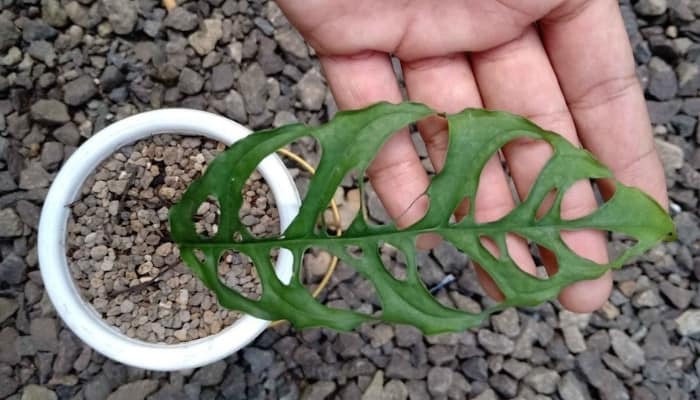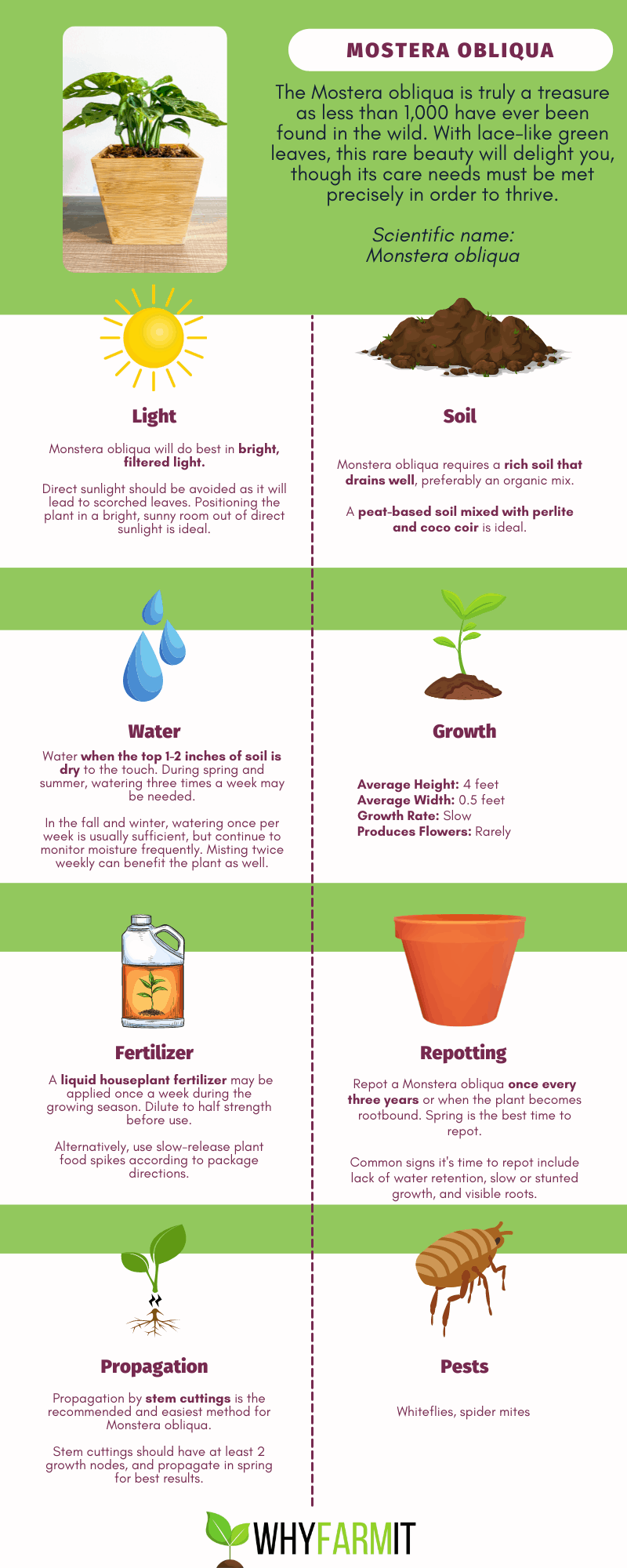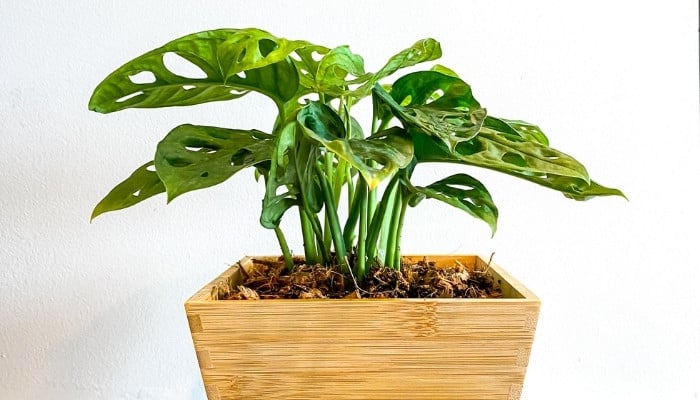The Monstera obliqua presents itself as an odd and fragile specimen. It boasts slender, paper-thin foliage that hosts more openings than a piece of Swiss cheese!
Thankfully not the work of pests, this is a natural feature of its growth known as fenestration and can be quite difficult to maintain.
How do you care for Monstera obliqua? This rare plant needs a rich organic soil that drains well; bright filtered light, temperatures of 59-77°F, and humidity levels between 80-90%. During the growing season, water up to three times a week and fertilize with half-strength houseplant fertilizer once per month. In winter, water weekly.
Caring for Monstera Obliqua: Basic Guidelines
The many holes in the Monstera obliqua leaves better allow for the passage of water to lower parts of the plant – an evolutionary feature enabling its survival in the rain forest floors.
Caring for this fragile plant in your home is no easy task, but following our care guide – including pro tips on fertilizer, soil, FAQs, and more – can set you on the path to success.
Complete Care Guide for Monstera Obliqua
The Monstera obliqua houseplant is so rare a find that prolific American plant collector and botanist Dr. Thomas B. Croat has described them as “a botanical unicorn.”
Originally documented by German botanists Johann W. Krause and Adolf Engler in 1908, this plant has since been confused with similar-looking Monstera species, and it is scarcely available outside of private collectors.
Monstera Obliqua at a Glance
- Plant Type: Evergreen hemiepiphyte
- Scientific Name: Monstera obliqua
- Average Height: 4 feet
- Average Width: 0.5 feet
- Growth Rate: Slow
- Produces Flowers: Yes
- Common Pests: Whiteflies, spider mites
- Life Expectancy: Years with exceptional care
- Difficulty of Care: High
What To Do When You First Get Your Monstera Obliqua
- Make sure the soil surface is moist – Only water if it feels dry when you stick your finger in the top few inches of soil. If the soil is already moist, check back the next day to allow it to dry out in between watering.
- Plant it in its ideal soil recipe – According to Monstera Plant Resource Center, most Monstera obliqua growers prefer to use a custom organic soil medium instead of a commercial mix, so it might be worth asking the seller for their recommended formula.
- Give it climbing support – as a climbing plant, make sure you give it something to lean against – tying the plant gently to a growing stake like a moss pole is advisable or have it grow against a taller, larger plant.
Ideal Soil for Monstera Obliqua
This plant thrives in a well-draining mix with plenty of additional organic fibers to help it retain much-needed moisture without compacting the soil.
Horticulturist Ben Hilton of The Yard and Garden blog recommends “peat-based soil combined with perlite (granular material) and bark such as coconut coir.”
Ideally the soil pH should measure between 5 and 7. With a plant as rare as this one, you don’t want to take a chance on guessing at the pH level.
Purchase a pH tester to be sure you’re providing optimal growing conditions.
This one not only measures soil pH, but it also accurately monitors light and moisture levels as well and is quite affordable.
Monstera Obliqua Water Requirements
The health of this plant can be very temperamental with improper watering, so you should aim for the soil to remain damp, not soggy or dry by checking the top few inches with your finger daily.
You can alternatively use a moisture meter (see above) to help decide the watering frequency, which may be thrice weekly during summer and once per week during winter.
Monstera Obliqua Lighting Needs
This plant will need bright but filtered sunlight to mimic the dense rain forest canopy it’s accustomed to.
Placing it on a window with partial shade from a sheer curtain or on a middle or lower shelf of a bright room will be ideal.
Darker homes are encouraged to use LED grow lights, like this lightweight, inexpensive model, enabling you to set the sunlight levels for your Monstera obliqua.
Ideal Temperature Range for Monstera Obliqua
Between 59-77°F (15-25°C) is a good range for Monstera obliqua, though try to keep it at a consistent 68°F when possible throughout the year.
Be mindful of your use of artificial grow lights over winter to prevent temperature spikes, and keep the plant far from drafty areas, as 39°F and below will kill it.
Ideal Humidity Level for Monstera Obliqua
For Monstera obliqua, 80-90% is ideal to replicate their south and central American jungle habitat. The delicate lacy leaf structure needs consistent high humidity to remain intact.
Unless you live in the tropics, you’ll want to purchase a humidifier (this whisper-quiet model doubles as a nightlight and runs for 25 hours at a time) to maintain its own microclimate.
Misting twice weekly can also be beneficial during winter.
Best Location for Monstera Obliqua
A warm conservatory can be ideal as this is akin to a sheltered, humid greenhouse.
The bathroom is another great location for meeting the brightness, temperature, and humidity levels, so long as the plant will not be close to radiators or AC drafts.
Monstera Obliqua Growth Habits
Monstera obliqua has a bushy, compact form as a juvenile, but can be coaxed into being a climbing plant.
It climbs in its natural rain forest habitat to reach the sun, anchoring its roots to trees to scale further up the canopy.
Fertilization Type & Schedule for Monstera Obliqua
A liquid fertilizer diluted at half strength will be beneficial when used once monthly from spring to summer.
Horticulturist Ben Hilton recommends “Jobe’s fertilizer spikes for a consistent slow-release feed.”
If you can use organic fertilizer, all the better. Vermicast (earthworm poop) is often mentioned in Monstera care circles to enrich the soil with nutrients and improve soil aeration too!
Signs of Nutrient Deficiency
The leaves of your Monstera obliqua are very sensitive and will normally turn pale, develop yellow or brown areas, or appear crispy or wilted if their conditions are poor.
Maintaining their ideal environment as discussed will encourage proper nutrient intake and prevent foliage damage.
Pruning Monstera Obliqua
These won’t require regular pruning as they are quite slow growers, but you can help control growth and trim off any dead or damaged leaves as they appear using sterilized pruning shears.
Does Monstera Obliqua Produce Flowers?
Flowers are possible, but these are rarely produced indoors and consist of subtle blooms when they do happen to form.
Monstera obliqua can flower randomly during the year and produce cream petals or spathes surrounding a green spadix (fleshy spike) which turns to orange if the berry-like fruits are produced.
Is Monstera Obliqua Toxic?
Yes, all Monstera plants are deemed toxic to humans and pets due to containing insoluble calcium oxalate crystals that can cause acute oral pain, swelling, and vomiting when ingested.
Monstera Obliqua Propagation
This plant can be propagated (multiplying your plant collection from cuttings of the parent plant) by stolon propagation or stem cuttings.
As the latter is the easiest method of the two – especially for novice growers of Monstera obliqua – let’s detail how stem cutting propagation works:
1. Wait Until the Growing Season To Begin Propagating
Taking stem cuttings from your Monstera obliqua is best done at the start of spring or summer when the shoots are still nimble enough to be cut easily before they mature and harden.
Your plant will also feel less stressed about being re-planted in its natural growth period than any other season.
2. Take 5-7 Inch Stem Cuttings With at Least 2 Nodes on Each
Selecting healthy stems growing from the main stem stalk, snip a 5-7 inch piece of stem with clean pruning shears.
Make sure each cutting has at least 2 growth nodes (the point of attachment to the potential leaves).
3. Plant Each Cutting in a Pre-Prepared Pot & Water Generously
You can now plant each new stem cutting into their own pots (it helps to prepare new pots beforehand by filling them 1/3 of the way with your chosen soil recipe to keep them anchored).
Once planted, fill with soil, and water each one well.
4. Allow a Few Weeks for Development & Refrain From Fertilizer Use
It will take a few weeks for the roots to properly develop from your new stem cuttings, so expect to see some (slow) signs of growth up to a month after propagating.
You should also refrain from using fertilizer on them for at least the first 3-4 months to give the new shoots a chance to develop naturally in their environment.
Repotting Monstera Obliqua
As a slow grower, your Monstera obliqua can spend a while in the same plant pot, but occasional re-homing will be necessary to maintain soil health.
When To Repot Monstera Obliqua
Repotting will normally be required every 3 years.
Within this time frame, the roots may begin peeking out from beneath the pot drainage holes or become rootbound (circling within the pot).
After a while, the soil medium may no longer drain as well, and the roots may have become damaged, so repotting offers the opportunity to give your plant a health checkup.
Signs That It’s Time To Repot
- The plant is outgrowing its current pot.
- Roots are appearing beneath drainage holes and encircling the soil.
- Your current soil mix no longer drains well.
How To Repot Monstera Obliqua
1. Repot During Summer & Within 2 Days of the Last Watering
As with propagating, repotting your Monstera obliqua is best done during the summer growing season for minimal stress.
Repotting will be easier to do if the soil is still fairly moist from a recent watering (2 days at the most). You can then slide it out of its container pot with ease.
2. Gently Brush off the Old Soil & Check the Root Health
With the soil nicely damp, you should be able to break apart the soil by hand (if it is tougher than expected, you can use a sterile knife to break apart clumps).
Once the roots are exposed, check for signs of disease or damage – healthy roots should be firm to touch and pale in color, not mushy or black.
3. Trim off Any Diseased Roots & Re-Plant in Pot 2 Sizes Up
Cut off any damaged roots with a clean, sharp knife or pruning shears, and re-plant your Monstera obliqua in a pot at least 2 inches wider than its previous one.
Fill the new pot beforehand with 1/3 ideal soil medium and place your plant in to stabilize the roots.
Fill the pot with soil to the same depth the plant was accustomed to, and water it thoroughly, allowing a similar period for settlement as with propagation.
Monstera Obliqua Common Problems & Solutions That Work
Monstera Obliqua Common Pests
Even with less leaf surface area than most species, these plants can still be prone to sap-sucking nuisances from time to time. Here are two common culprits and how to deal with them:
Whiteflies
- Signs of Trouble – Clusters of white, triangular flies on leaf undersides, sticky honeydew residue on foliage.
- Solution – Spray infested areas with warm, soapy water or an organic pesticide, like neem oil.
- Prevention – Ensure humidity isn’t too high, place sticky traps near plant.
Spider Mites
- Signs of Trouble – near-transparent red/yellow mites on foliage underside, sticky webbing.
- Solution – Dab area with a wet cotton pad, spray remainder off with warm, soapy water.
- Prevention – Mist leaves regularly, consider replacing top soil layer to remove potential mite larvae.
Monstera Obliqua Common Diseases
With improper care and unhygienic practices, the delicate leaves of your Monstera obliqua can easily fall victim to fungal conditions and viruses.
Make sure you are there to spot the signs sooner rather than later:
Mosaic Virus
- Signs of Trouble – Small yellow lesions forming mosaic-like pattern on leaves
- Solution – Prune affected leaves with clean shears, and quarantine plant at least 2 feet away from other houseplants.
- Prevention – Ensure shears and tools are cleaned between use, never re-use old potting soil, and keep the Monstera obliqua far from other plants to prevent pest and disease transmissions.
Root Rot
- Signs of Trouble – Yellowing leaves, stunted growth, soft and black roots.
- Solution – Trim off diseased root sections. Repotting in fresh soil may be necessary.
- Prevention – Use well-draining soil medium, review watering frequency, and check humidity levels.
Other Common Problems
Even with consistent good care, it’s easy to drop the ball with something in your routine, and this plant will usually let you know in the following ways:
Browning Foliage
- Signs of Trouble – Brown tips and edges of leaves.
- Solution – Prune affected leaves, and place plant in softer lighting conditions.
- Prevention – Ensure humidity levels are correct, and review watering schedule.
Yellow Foliage
- Signs of Trouble – Yellowing leaves close to the soil.
- Solution – Prune affected foliage, and allow top soil layer to dry before next watering.
- Prevention – Reduce watering frequency, and ensure lighting conditions are ideal.
Monstera Obliqua Common Questions

How Much Does a Monstera Obliqua Cost?
Monstera obliqua plants can go for as much as $23,000 at auction, according to this plant collector.
Monstera hobbyist Anastasia of the Bloom Sprouts blog also shares that “a single cutting can cost between $5-8,000 USD.”
Why Are Monstera Obliqua So Expensive?
The combined characteristics of incredibly slow growth, delicate and fragile foliage, demanding care, and low numbers in the wild have put this exotic plant variety in extremely high demand.
Why Are Monstera Obliqua Rare?
According to the online houseplant community Plantly, their rarity can be attributed to “their small size, short selling seasons, slow growth” but mostly because they are “the toughest Monstera variety of all to keep alive” due to their particular care needs.
How Many Types of Monstera Obliqua Are There?
There are four true types of Monstera obliqua: the ‘Peru’, ‘Bolivia’, ‘Panama’, and ‘Suriname’ varieties.
The Peruvian variety is often regarded as the most popular and widely photographed type due to its heavy fenestration, but not all varieties share an equally holey quality.
Do Monstera Obliqua Climb?
It will naturally climb in the wild by anchoring aerial (above-ground) roots to nearby trees in a bid to reach the sunlight.
As these plants gradually grow beyond their bushy juvenile form and attain tall, upright growth, climbing can be encouraged with the aid of a stake or larger plant.
Is Monstera Obliqua Variegated?
They are not variegated due to their uniform rich-green color. Variegated plants display white or light green shades in their foliage when less chlorophyll is produced due to a rare genetic mutation.
While variegated Monstera obliqua varieties may occur, botanist Briana Yablonski from Petal Republic reveals this occurs in “1 out of every 6,000 plants.”
What Is the Rarest Monstera?
The large ‘Mint’ variegated Monstera deliciosa is considered the rarest variety, due to the attractive light mint green and dark green variegation in its foliage.
Floral Daily revealed that one mint M. deliciosa sold in the UK for £28,200 ($39,122) on eBay in early 2021 due to “houseplant demand skyrocketing during the pandemic.”
Is Monstera Obliqua the Same as Monstera Peru?
No, Monstera ‘Peru’ or Monstera karstenianum is a separate species from Monstera obliqua within the Araceae family.
Not to be confused with the Peruvian variety of Monstera obliqua, this plant instead has waxy, full (no fenestration) succulent-like leaves that are puckered and has a climbing growth habit.
Monstera Obliqua vs. Monstera Adansonii (Swiss Cheese Plant)
Both plants appear similar in their early stages, but Monstera adansonii goes on to develop robust leathery leaves with lighter fenestration compared with Monstera obliqua whose leaves are paper-thin and heavily perforated with no symmetry.
Plants sold as Monstera obliqua for no more than $50-100 are more than likely Monstera adansonii in disguise.
3 Key Tips for Success With Monstera Obliqua
1. Ensure Lighting Conditions Are Just Right
Monstera obliqua need the Goldilocks approach when it comes to sunlight to prevent scorching those oh-so-fine leaves.
Be mindful of the light intensity in your chosen plant room and place white curtains in the window if you notice brown tips.
Biologist Sara E. Taylor of the Indoor Garden Nook advocates the use of LED grow lights to “let you control the light intensity.”
2. Heap on the Humidity To Keep It Happy
It needs an extremely high humidity threshold to survive, but this is doable with sensible placement and consistent measures.
Julia Lewis at The Little Botanical blog advises: “keeping it on a bathroom unit or corner to allow the characteristic Monstera leaf split to form.”.
Outside of the bathroom, use a humidifier, and mist it every morning when it is at its most rigid.
3. Have Patience & Enjoy Their Slow Growth
Did you know that it can take several years for the true lacy leaf fenestration to really kick in?
Before then, it may appear to have the same amount of holes as the Swiss Cheese plant, so take its slow growth in stride – be careful not to over-fertilize, overwater, or repot/propagate before it’s time.
Conclusion
To sum up, the fairly demanding Monstera obliqua is not for the beginner grower, but this can make a truly beautiful and unique houseplant for owners who are consistent (and lucky enough) to take on the challenge.
Its stellar feature of intricate fenestrated foliage can easily crumble in a poor growing environment, so absorb all the pro tips you can if you want this elusive and expensive plant to thrive.

Sources:
https://theyardandgarden.com/monstera-obliqua-care/
https://indoorgardenook.com/monstera-obliqua-ultimate-care-guide/
https://plantophiles.com/plants/monstera-obliqua/
https://blog.inspireuplift.com/monstera-obliqua/
https://www.aroid.org/genera/monstera/Madison_Monstera_Rec.pdf
https://forum.gardenersworld.com/discussion/1027807/drooping-monstera-obliqua-monkey-mask
https://www.aspca.org/pet-care/animal-poison-control/cats-plant-list
https://www.gardeningknowhow.com/composting/vermicomposting/worm-castings.htm
https://www.house-plant-hobbyist.com/blog/2019/11/12/monstera-obliqua-fact-and-fiction
https://www.petalrepublic.com/variegated-monstera/
https://terrariumtribe.com/terrarium-plants/monstera-karstenianum-monstera-peru/

